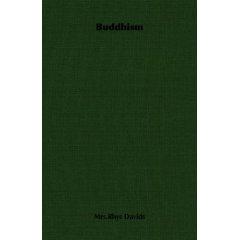| 2020ok Directory of FREE Online Books and FREE eBooks |
Free eBooks > Religion & Spirituality > Buddhism > General > Buddhism
Buddhismby Mrs. Rhys Davids  Download Book (Respecting the intellectual property of others is utmost important to us, we make every effort to make sure we only link to legitimate sites, such as those sites owned by authors and publishers. If you have any questions about these links, please contact us.) link 1 About Book Book Description Text extracted from opening pages of book: tOME UNIVERSITY LIBRARY ' F MODERN KNOWLEDGE BUDDHISM BY MRS. RHYS DAVIDS, M. A. LONDON WILLIAMS & NORGA T$ R HENRY HOLT & Co., NEW YORK CANADA: WM. BRIGGS, Toi& tn& : R. & T. WASHBOURNE, LTD. PRINTED BY THE LONDON AND NORWICH PRESS, LIMITED LONDON AND NORWICH TO MY TEACHERS G. GROOM ROBERTSON T. W. RHYS DAVIDS * Too little payment for so great a debt* CONTENTS CHAPTER PAGW I THE PALI TRADITION-. . . .9 II DHAMMA AND ABHIBHAMMA . . . .32 III THE NOBM AS THEOBY OF No-SoxiL , . 48 IV THB NOBM AS THE LAW OF CAUSATIDK . . 78 V THE NOBM AS MOBAL LAW . . . .107 VI THB NOBM AS IDEAL 150 VII THB NOBM AS IDEAL ( continued) . . . 173 VIII THH QUEST OF THE IDEAL .... 198 IX THB IMPOBT OF DHAMMA .... 234 CONCLUSION ...... 240 CHBONOLOGICAL NOTE 249 BIBLIOGRAPHY 251 INDBX . 255 BUDDHISM CHAPTER I THE PALI TRADITION THE general growth of interest in Buddhism is due to more than one assignable cause. But we may class the various causes fairly enough under the growth of general know ledge. And under this fact of expanding knowledge we may distinguish between growth of intellectual curiosity and sympathy in the knower, and additional facilities in the means of knowing. We must resist the temptation, in the limited scope at our disposal, of lingering over the former group of causes, and glance forthwith at the latter. In the first place we are now beginning to reap the harvest sown by certain pioneers, who returned last century from countries where creed and culture are or have been Buddhist, in their hearts the wish, on their shoulders the task, to make known in the West a literature venerable in its tradition, and, where still followed, a living force in the present, but practically unknown outside 10 BUDDHISM Asia. This was the religious literature of Ceylon, Siam, and Burma, written on palm leaf manuscripts, and, for the most part, in a language not at any time native to any of those countries, but hailing from the ancient dialects of North-East India. Closely akin to this language, which, as a literary diction, is known in the mediaeval portion of the litera ture as pdli ( or The Text), is that of certain inscriptions carved on rock and pillar, found in different parts of India. These are known as the Edicts of the Emperor Asoka, the Indian over-lord who reigned about 272-35 B. C. They consist largely of injunctions to righteous and fraternal conduct, and refer to passages contained in the most ancient of these same Pali compositions. These oldest compila tions are treasured, in the three countries above-named, as canonical scriptures. And the Pali language is judged to be a literary version of an Indo-European or Aryan dialect, later than the language of the Vedas and Brahmanas, or oldest known Brahmin texts, but earlier than what is called Sanskrit, that is, the literary language of India during nearly the whole of the Christian era. Now this Pali was the vehicle of what is, so far as we have yet been able to discover, the earliest formulated records of Buddhism. Dead as a vernacular, it still lives on as a literary instrument in the native colleges or monasteries of Ceylon, Siam, and Burma, just as Latin was the mediaeval, and is, to THE PALI TRADITIO^ 11 some extent still, the modern vdtdtele ecclesiastical Christianity. In its veri or spoken form, it appears to have been the alanguage, according to Buddhist commen rtarial tradition, of Mag'adha, according to Rhys Davids, of Kosala, about the fifth century B. C. ( or earlier) and subsequent cen turies. It was in the kingdom of Kosala that the Buddhist movement took firmest root, growing up in the great college at Savatthi, the site of which has during the last few years been excavated. So that although the first Buddhist Emperor, Asoka, was of Magadha, south of Kosala, and established his capital at Patna on the Ganges, the Buddhist canon had already been compiled ( though not yet written) more or less in its present form in Kosalese, and not Related Free eBooks | Related Tags |












SEND A COMMENT
PLEASE READ: All comments must be approved before appearing in the thread; time and space constraints prevent all comments from appearing. We will only approve comments that are directly related to the article, use appropriate language and are not attacking the comments of others.